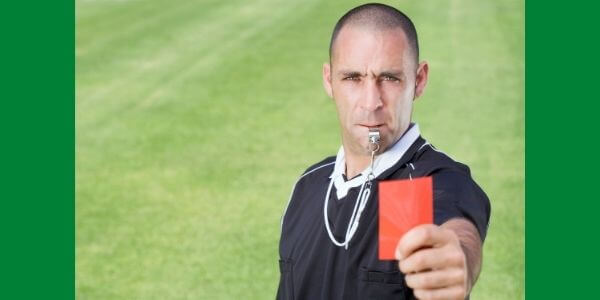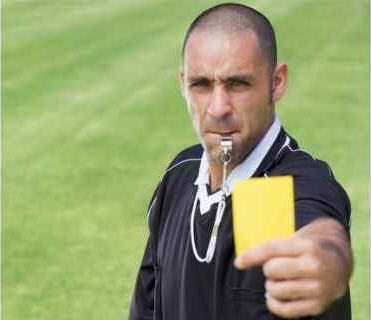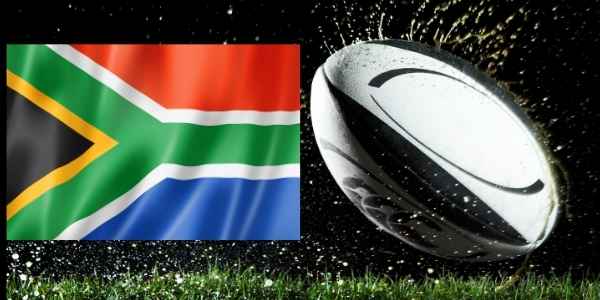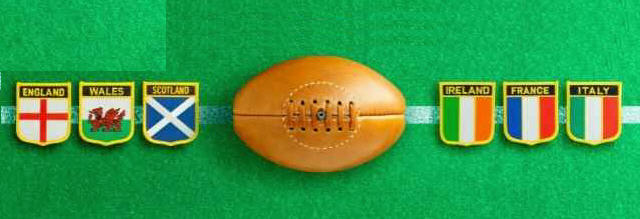Players have been sent off in rugby since the early days of the game. But red and yellow cards are a relatively recent innovation in the sport.
Rugby Union borrowed aspects of card sanctions from soccer and ice hockey. You may be surprised to learn that the first yellow cards in international rugby matches didn’t mean the player had to leave the field. The “sin bin” came later.
What Does A Red Card Mean In Rugby?

A red card in Rugby Union is the highest sanction that the referee can give on the pitch.
The player leaves the field immediately and cannot return to the match.
As red-carded players cannot be substituted, their team is down in numbers for the rest of the game.
Being down a player is a significant disadvantage in a physical sport like rugby.
If the red card happens early in a match, I would always expect that team to lose.
Teams may hang on for sixty minutes with tactical kicking and extra effort in defense. But usually the last twenty minutes see the opposition running in tries against a tired team.
In contrast, teams often weather the ten minutes of a yellow card.
What Does A Yellow Card Mean In Rugby?

A yellow card in Rugby Union means that the offending player must leave the pitch for ten minutes.
The player can return to the field of play after the duration of the sin bin.
A second yellow card to the same player is upgraded to a red, and the player cannot return to the match.
In my experience, it’s rare for players to get a second yellow card. They usually clean up their act when they come back onto the pitch.
Sometimes, a coach sees that the player’s head is in the wrong place. They’re too pumped up or angry and are likely to commit another infringement.
A good coach will substitute the player to avoid the massive disadvantage of a double yellow i.e. a red card.
What Is The World Cup Review Bunker?
The TMO bunker is the latest innovation to the rules of yellow and red cards.
The bunker is a closed area at a stadium where a small number of television match officials (TMOs) monitor a match for foul play.
They have two key roles:
- watching out for foul play
- upgrading yellow cards to red
Monitoring Foul Play
They can call attention to incidents that the referee may have missed. The field referee will hear in his earpiece that there is an incident for review.
You will see the ref cross his arms to show to the crowd what’s happening. Then he’ll run to the best vantage point to see footage of the incident on the stadium screen.
The referee gets advice from the TMOs but ultimately takes the decision as to whether the incident deserves just a penalty or requires a card.
Upgrading Yellow Cards To Red
This is perhaps the biggest change brought in by the bunker. When a referee issues a yellow card to a player, that’s not the end of the possible sanction.
The offending player leaves the pitch to sit on the sidelines for the mandatory ten minutes.
The new bunker system means that the TMOs have eight minutes to review the footage and decide whether the card should be elevated from yellow to red.
This happened to the England captain, Owen Farrell, in a warm-up match before the World Cup. There have been more card elevations during the World Cup itself.
Can A Carded Player Be Replaced?
Players who receive a yellow or red card cannot be replaced directly. Their team is down in numbers for the duration of the sin bin period. With a red card, that is for the rest of the match.
However, other players can be substituted in response to the card. So if the scrum half is sent off the pitch, the coach may decide to substitute a winger in order to bring on the substitute scrum half.
Sometimes, the laws of rugby demand that a player is substituted. This applies to the front row i.e. prop forwards and hookers.
You can read an in-depth explanation in our article on substitutions in rugby. We’ll summarize it here:
Carded props and hookers must be replaced for scrums
When a front row player is carded, the team must bring on another front row player for scrums.
This is because front row positions require very specialist skills in the scrum. Players who don’t have good technique and experience when pushing in a scrum could suffer neck injuries.
However, the carded team can’t suddenly get an “extra” player back just because there’s a scrum. The coach must substitute a player already on the pitch to bring on the front-row forward.
Often, this is a flanker if the coach decides to scrum with seven players. Sometimes it’s a wing. It depends on the match scenario.
When Were Red Cards Introduced In Rugby Union?
Players have been sent off the pitch for bad infringements since the earliest days of the sport. As far back as 1888, the codified rules included sending off for foul play.
In 1938, the British administrators placed a notice in the Sunday Post newspaper.
I am instructed to request you to bring to the notice of your committee and players the very large increase in the number of cases by which referees are being compelled to order players off the field.
Sunday Post, 1938
But it’s not true to say that red cards existed in these older times.
The referee didn’t carry cards in his pocket. He simply blew his whistle and pointed to the side of the pitch. “You’re off, sir”.
We only needed red cards in the sport with the advent of a different sanction that also sent players from the field: the yellow card offense.
Red cards were introduced into Rugby Union along with yellow cards. So, let’s look at the history of yellow cards.
When Were Yellow Cards Introduced In Rugby Union?
Other sports like soccer and ice hockey had introduced the concept of a sin bin or a “cooler”.
Introduction of the cooler

South Africa led the way in Rugby Union in the early 1970s. The South African administrators suggested that a cooler be brought into rugby.
They put forward the proposal in 1972, but it was rejected by the other countries in the sport.
In 1979, the international rugby board agreed to let South Africa use the cooler in their domestic competitions. Players left the field of play for a period of five minutes.
However, the cooler wasn’t really for players who committed an infringement that didn’t quite warrant a red card.
It was for players who were so riled up that they were likely to throw a punch…and maybe get sent off (I say maybe, because a punch back then wasn’t an automatic red card!)
The idea was that pumped-up players would calm down and “cool” their heads.
1995: first yellow cards in international matches (but no sin bin)
By 1995, the southern hemisphere was using a similar system of yellow and red cards as in soccer.
The yellow card put the player on a warning, but the player didn’t have to go off the pitch.
That year, the All Blacks were touring France. In a spiky mid-week match against a club in Nancy, lock Mark Cooksley punched a French player.
The referee showed him a yellow card. (“Do that again and you’re off!”)
However, the Irish referee had jumped the gun. The authorities hadn’t sanctioned yellow cards for international matches yet!
The “official” first yellow card was in a match between Ireland and England in Dublin.
This was part of the Five Nations championship (i.e. before Italy joined to make it the Six Nations).
England’s Ben Clarke stamped on the blonde Irish winger Simon Geoghegan. Both players were club mates at Bath Rugby Club!
The referee flashed the yellow card at Clarke, who stayed on the field but on a warning.
2000: first yellow cards with sin bins

The International Rugby Board introduced some experimental laws in the sport after the 1999 World Cup. This included the ten-minute sin bin for a yellow card.
The Six Nations championship in 2000 was the first international competition where a yellow card required the player to leave the pitch for ten minutes.
Some of those experimental laws were ditched after a season. But the sin bin was here to stay.
Does A Red Card Mean A Ban In Rugby?
A player must commit a very serious infringement to receive a red card. So, the outcome for the player doesn’t finish with only missing the rest of that match.
Every red card in rugby leads to a disciplinary committee reviewing the incident. Some infringements lead automatically to further match bans.
A punch to the head will bring a minimum four-week ban, and often longer.
You can check out our article on bad dump tackles and tackling players in the air. If the opponent lands on his head, the likelihood is a match ban of at least two weeks.
Can Players Appeal A Red Card In Rugby?
Rugby players have the right to appeal a red card.
Professional players can attend a disciplinary hearing to make their case that the card was too harsh for the infringement.
Amateur players can send written appeals to their rugby union.

All appeals start with a disciplinary committee reviewing the referee’s report from the game.
If there is television footage available, that will also be studied. Of course, this rarely applies at amateur levels.
It’s very rare for a red card to be overturned after a match.
Rugby Quiz!
Think you know your rugby?
Let's see if you can match the quote to the player or coach!
Here are seven quotes. How well will you do?
